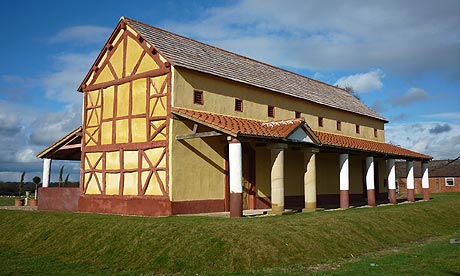
Reconstrução de uma residência romana na Inglaterra. Construída, quase ao pé da letra, a 'moda' romana. Os romanos não possuiam carrinhos de mão, mas os pedreiros não abriram mão dele…rs
 Tradução para o Português [Google] aqui:
Tradução para o Português [Google] aqui:Ideal domus: the Romans liked colour and excess, according to Dai Morgan Evans, who dreamed up the Wroxeter project. Photograph: Wroxeter Roman Cityguardian.co.uk
Good taste is not a feature of a new Roman house that has risen, with much sweat and cursing, from a flat Shropshire field at the genuinely ancient Roman town site of Wroxeter: painted bright yellow and oxblood red, the building can be seen a mile off,
The wall, which is 7 metres (23ft) high and stands on top of a metre-high mound, protects the remains of an real ancient Roman forum.
"Colour, bling, excess – that's what they liked," said Dai Morgan Evans, visiting professor of archaeology at Chester University, who dreamed up the elaborate experiment yet attempted in Britain in recreating a building using genuine Roman techniques. "I always had the hope that a Roman would come here and not see anything too funny. I reckon we got it about 80% right."
They had to take some shortcuts, including using some machine-cut roof trusses, in order to get the building finished before what proved to be the coldest winter in a century. He has already taken a kicking from some of his peers over that, and even more so over the oak shingled roof (rather than tile or thatch) and the bull's intestine windows in the bath house.
"There's no evidence for it, but there's no evidence against it," Morgan Evans said. "They could well have used it here but it would have rotted away centuries ago."
It took a team of seven builders six months, 150 tonnes of sandstone bricks, 15 tonnes of lime mortar and 26 tonnes of plaster – all mixed by hand – 1,500 hand-cut timber joints and 2,600 hand-cut roof tiles to create the house, based on a real building excavated at Wroxeter, which was once the fourth largest city in Roman Britain and is now an archaeology visitor attraction in the care of English Heritage.
The workers, more used to plasterboard and plastic windows, had no experience of traditional techniques. A Channel 4 series, Rome Wasn't Built In A Day, tracked their steep learning curve – and the running battle of the wheelbarrow.
The builders were incredulous when Evans insisted that, however advanced their plumbing and road-building, the Romans had no wheelbarrows, so everything had to be carried on to the site by hand. The builders kept smuggling in wheelbarrows; he kept throwing them out. When the roof boards were on, they wrote in giant letters "Romans had wheelbarrows" – now covered by the shingles.
"They absolutely did not have wheelbarrows," Evans said. "I've done a lot of work on this now. They had wheelbarrows in China, but there is no record, drawing or evidence for a wheelbarrow anywhere in the Roman empire. The first reference I can find is Isidore of Seville, and that's in the seventh century – centuries after our house."
The builders are now happily back at work on a pair of bog-standard 21st-century redbricks. The foreman, Jim Blackham, said: "It was really interesting to be part of this, but it's nice to be back to modern machinery – and wheelbarrows."
The Romans may have invented central heating, but as the Roman re-enactors brought in for the preview discovered, when rain blows in on a bitter wind from the Shropshire hills, the house with all the rooms built on to an open loggia is absolutely freezing.
The underfloor heating was only for the bath house, which takes several hours to fire up and would never have been used every day. The rooms would have been heated with charcoal braziers, meaning too much carbon monoxide in the atmosphere would have been a real menace. When Evans tried it, the experiment was abandoned after an hour when the sensors showed the gas had already reached danger levels.
"We know it nearly killed one emperor, and did kill another, when they redecorated a room for Jovian but the paintwork hadn't quite dried so they stuck in a brazier. There's lots more work we can do here on carbon monoxide," he said.
The house has planning permission for the next five years, and if the decision is then taken to keep it he believes it should stand for at least a century.
Wroxeter Roman town house is open to the public as part of admission to Wroxeter Roman City from Saturday.






0 Comentários